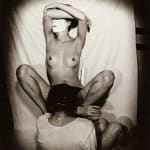

Eikoh Hosoe
Kamaitachi #2, 1968
Silver gelatin print, printed later
Paper size: 51 x 40.5 cm
Image size: 45 x 30.5 cm
Image size: 45 x 30.5 cm
Initialled in ink recto
Signed, titled and dated in pencil verso
Signed, titled and dated in pencil verso
Provenance
Eikoh Hosoe Estate, TokyoLiterature
Eikoh Hosoe is one of Japan's most iconic post-war photographers, recognized for his legendary collaborations and impeccable aesthetics.Hosoe had adopted the experimental dancer and ankoku butoh pioneer Tatsumi Hijikata as a kind of muse years before he proposed the experimental portrait series that would become Kamaitachi. Mining their shared memories of growing up in the rural northern province of Tōhoku and this region’s wild folkloric imagery, they worked together to create a dance-drama both cinematic and intensely physical. The title ‘kamaitachi’ refers to a weasel-like demon who allegedly haunted local rice fields, slashing unlucky wanderers who crossed his path. Drawing on these mythic associations of speed and violence, Hijikata danced through the landscape of his youth to perform a theatre of the fields for Hosoe’s camera.
Hosoe has received the Royal Photographic Society's 150th anniversary special medal, for a lifetime contribution to art. He has also been awarded The Medal with Purple Ribbon (1998), The Order of the Rising Sun (2007), the Mainichi Art Award (2008), and he was designated as a Person of Cultural Merit by the Ministry of Education (2010). He has been the subject of numerous solo and group exhibitions in Japan and abroad, and his photography is held in the permanent collections of many public institutions including The Metropolitan Museum of Art, New York, The British Museum, London, The J. Paul Getty Museum, Los Angeles, and The Museum of Modern Art, San Francisco.

